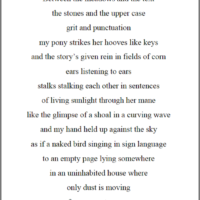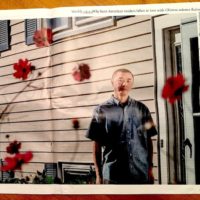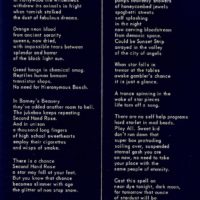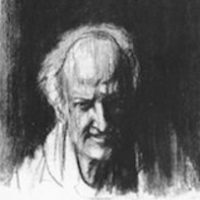Whatever the blowhard president of Trumpistan says in his official proclamation to honor Martin Luther King Jr., rest assured it is phony to the last pixel and not worth the time to read it. (To save you the trouble, here’s a sample: “My Administration works each day to ensure that all Americans have every opportunity to realize a better life for themselves and their families regardless of race, class, gender, or any other barriers that have arbitrarily stood in their way.”) And for the record let’s not forget that when King made his historic “I have a dream” speech from the steps of the Lincoln Memorial in 1963, it was hardly noticed by the nation’s most widely circulated newspapers. Have a look at King delivering that speech and be reminded of what they missed.
Kurt Wold: ‘Stradoferous’
“I dreamt I could play the bicycle. This performance artwork plays with a number of themes, not the least of which is the continual contemporary pressure to present oneself as larger-than-life, in the hope that one might be noticed in a distracted culture. Of course the work also revels in those distractions.” — Kurt Wold
If This Was an Actual Real-Time Photo . . .
. . . which it was . . . You have to wonder what floor can I get out? [Insert punchline, pls.]
A Poem and Its Genesis: Malcolm Ritchie’s ‘Writing It’
… and my hand held up against the sky / as if a naked bird singing in sign language / to an empty page lying somewhere / in an uninhabited house where / only dust is moving / from room to room … — from “Writing It”
And From the Outlaw End of the Writing Spectrum
“At age 84, Plymell continues to write, publish and perform—“doing nuttin”, as he says—from his home in Cherry Valley, New York. His activities keep Plymell in steady correspondence with a crowd of like-minded hellions, including rockabilly’s Bloodshot Bill, Sonic Youth founders Kim Gordon and Thurston Moore, bassist Mike Watt, filmmaker Mark Hanlon, guitarist Bill Nace, photographer Philip Scalia and musicologist Byron Coley. Plymell and his wife, Pam, first happened upon Cherry Valley in late 1969 in coming to visit Allen Ginsberg and Peter Orlovsky at their East Hill farm. Moving there for good in early 1970, the Plymells have set into adding to their immense creative legacy.” – Benito Vila
Poetry in Prose: Cheever’s Domestic Confessions
‘I make no headway, and yet it seems best to come here every day and try. It is not easy. I have had winters before and will have them again, and do not seriously doubt that they will end—the winters—but it is not easy. I am reminded of the weeks and months in Rome when I saw nothing with the right eyes but a cobweb gleaming in the sunlight and an owl flying out of a ruin.’ — John Cheever, from his journals
A Blogpost for the Ages
This was it, Jan. 12, 2017 . . . It began like this: ‘On the day Twitter Fingers is sworn in as the preening el presidente of a tin-pot United States of Trumpistan, enabling him to run the country like a division of his family-held company . . . ‘ and continued with a 17-minute recording of Heathcote Williams reading his poem “The United States of Porn.” That reading alone puts the blogpost in a class of its own.
Before the Day Is Over . . .
… and the occasion becomes a nothing burger, here are a few greetings for the New Year … from Jürgen Schneider, Frank Diersch, Gerard Bellaart, and Charles Plymell.
Malcolm Ritchie: ‘The Wake’
“… we killed a few bottles / and drank to the dead …” — Malcolm Ritchie
NYT Magazine’s Designers Push the Envelope
The print edition of the New York Times this morning made note of the “Corrections We Remembered in 2019” (see the renamed, redesigned online version), pointing out that correcting a mistake is “more than a procedural obligation … it’s ‘an ethical responsibility.’” In that spirit I might as well point out that The Times can screw up badly when its highly trained and forward-looking designers push the envelope too far, particularly in the print edition of the magazine.
‘When Tarnish Stalked the Dust of Fabulous Dreams’
Charles Plymell’s poems are hard-core gems dug out of the earth. Yet they seem effortless to me. Without the slightest hint of literary elbow grease, they shine like polished jewels. I should have published more of them back in the day, but at least there was this one. It’s as gorgeous now as it was then.
Fluxus Impresario Readied for His Closeup
A feature documentary about the impresario of the international avant-garde art movement Fluxus from 1962 to 1978. Interviews with artists include Yoko Ono, Jonas Mekas, and Nam June Paik. Dedicated to cooperative methods and expanded processes, Fluxus could be everything and almost anything: kits, shops, festivals, islands, weddings, food, or Flux Lofts—a network of artist-owned lofts in SoHo, New York. The iconoclastic George Maciunas and the spirit of Fluxus provoke questions still critical to many working artists . . . and a helluva lot of silly serious fun.
When You Get to Your 85th . . .
“So I sit there with earphones, mind you West End of forgotten City East of what used to be a shade of time. Let’s not get into that again… machine gun fire loud & clear… airplanes moving in low & forgotten now like battles in the Pacific… distant artillery for the Americans don’t forget that buddy… sound of Japanese commandos… & Germany end of July 45, 17 sec. past the deadline… sunny morning in Hiroshima, stones trees houses people dust… it’s the 15th with transcribed music… cracks in the record, the unconditional surrender of Hollywood to TV…” — Jürgen Ploog
It’s That Time of Year . . .
. . . when it seems that everybody is looking back over their shoulder more with nostalgia than disgust. I am not immune. Scrolling through some old emails, I came across this one called “from NELSON ALGREN’S LETTERS TO RAJAH.” Rajah was Roger Groening, a friend of Nelson’s and later of mine. Roger died in 2015. I think of him often. He and Nelson became friends, initially by mail, when Roger wrote him a fan letter. They remained friends for some 20 years until Nelson’s death, in 1981.
Review: ‘Captivating … Teasing … Spare … Seductive’
“I was struck by poems made of lines that are poems all on their own—even as they unstack into melodic steps from top to bottom . . . Some are as spare as Chinese widsom. In Herman’s poems you know you are certainly ‘somewhere’ but maybe it’s somewhere only in atavistic memory, the realm of dreams. He writes with what Lavinia Greenlaw called ‘unsettled language,’ which brings less obvious aspects of imagination or observation to the fore . . . teasing, holding attention by where they might be heading. A doubtful adventure? A seductive noire? An obscene history lesson? And of course, mortality raises its knowing head more than once.” — Jay Jones
New Nationalism Suckled by Old Wolves
“The penultimate superstition of mankind is the State, and until the state has been rejected man will be a slave to darkness and ignorance: for fatherland, nation, country, patriotism, government are all black magic brewed in the witch’s cauldron of World History. The State Conscience, like its founders, Remus and Romulus, has always been suckled by wolves . . . ” — Edward Dahlberg
This Blogpost Is Personal
Ran into a tough opponent the other day. Took a header. I hit the pavement and it knocked me cold. Disfigured my face. An entire crew of firemen pulled up in full regalia, ladder engine included, had a look and got me a deluxe ambulance ride to the emergency room, plus a brainscan, a 24-hour overnight on a hospital gurney—the place was fully booked—and a bunch of stitches by a well-meaning young doc. Now home, condition improving, I got to thinking of Edward Dahlberg’s “Can These Bones Live.”






![Heathcote Williams [Photo: JH, 2013]](https://www.artsjournal.com/herman/wp/wp-content/uploads/2017/07/heathcote-williams-photo-copy-200x200.png)









